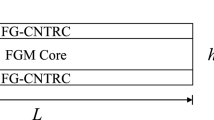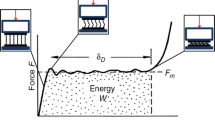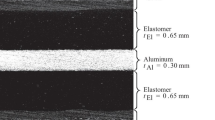Composite sandwich structures with a grid-stiffened core (SSGSC) are one of the new structural configurations employed in advanced industries, and therefore the knowledge of their dynamic characteristics is very important. Hence, in the present study, three composite SSGSC samples of glass/epoxy and carbon/epoxy were fabricated by the hand lay-up method using a silicon rubber die. Also, two metallic samples — a monolithic one and a SSGSC, made of Aluminum 1050, were fabricated. The core of the aluminum SSGSC was produced using the wire cutting process, and the face sheets were attached using a high-grade adhesive. Modal experiments were carried out on all the samples using B&K vibration equipment. The frequency, mode shape, and damping coefficients were obtained from each experiment. Finally, a numerical modal analysis was performed, and good agreement between experimental and numerical results was obtained.
Similar content being viewed by others
Avoid common mistakes on your manuscript.
Introduction
Composite structures with a grid-stiffened core (SSGSC) are of sandwich type. Grid composite structures are defined as a grid of rigid ribs that are connected together and make a strengthened structure [1]. They have a high flexural strength and stiffness and exhibit good acoustic and thermal insulation properties.
The first studies of grid-stiffened structures were carried out by Thomas [2], who produced an isogrid composite cylinder and subjected it to the axial compression. In 2000, he arrived at the conclusion that the thin skin of the cylinder do not help the ribs when their local buckling occurs. He also produced a reinforced isogrid plate, tested it in axial compression, and concluded that the cylinder and its grid stiffeners both can resist structural failure due to different loading directions [2, 3]. Steven et al. [4] elaborated two methods to produce grid-reinforced structures by molding [4]. Prakash et al. [5] investigated the specific energy absorption and failure of reinforced composite grid-stiffened plates in transverse quasi-static loading. In [6], they examined the possibility of optimization of such structures in order to maximize their energy absorption. Burgohain and Velmurugan [7], while studying filament-wound composite cylinders, introduced grid-stiffened composite structures because of their high efficiency in compressive loadings. They also showed that the high efficiency of these structures is due to the good load transfer property of ribs. Vasiliev et al. [8] provided information about the production, design, analysis, and mechanical properties of anisogrid composite structures for aerospace applications.
As already mentioned, the main concern of the previous studies was the strength analysis using analytical, numerical, and experimental methods. But, in none of them, vibrations of grid- stiffened structures have been investigated. Therefore, in our work, composite sandwich plates with a grid-stiffened core were fabricated, and modal vibration tests were performed on them to measure their vibration frequency, damping coefficient, and vibration modes. Since one of the applications of SSGSC structures is for flying objects, this study will help one to use these composite structures in aerospace engineering.
2. Sandwich Structure and Selection of Materials
Figure 1 shows a sketch of the grid core used for four SSGCS samples. The reinforcement materials were glass and carbon fibers, the latter ones used in the face sheets. For the core, unidirectional glass fibers were employed. The core and face sheets of the SSGSC samples were joined by an epoxy resin. The metal samples were made of the standard aluminum 1050 [9]. The mechanical properties of the materials are shown in Table 1, but the specifications of all the five samples are indicated in Table 2.
2.1. Production of a silicon mold
A wooden mold for a grid core with ribs 10 mm high and 8 mm wide was used to produce a silicon rubber mold. Then, silicon and 5 wt.% of hardener were mixed and poured into the mold. After curing the silicon rubber at room temperature for 24 hours, it was separated from the mold.
2.2. Production of composite samples
Sample 1 SSGSC, of dimensions 300 × 232.5 × 18 mm, had a 10-mm-thick core made of a roving. To produce the core, roving fibers were first impregnated with an epoxy resin and then put in the mold, as shown in Fig. 2. The lower face sheet, 4 mm thick, was made from five layers of woven glass fibers (300 g/m2) impregnated by the epoxy resin. Then, the lower face was fastened to the core, as shown in Fig. 3. After the gel time of resin, the rubber mold was removed, as shown in Fig. 4. Then, the upper face sheet was attached, as shown in Fig. 5. The fabrication and joining of the upper face sheet were similar to those of the lower face sheet. The first sample (1) was ready after 24 h of curing at room temperature. The additional parts were cut using an electric saw. The final samples are shown in Fig. 6.
Sample 2, of dimensions 300 × 232.5 × 14 mm, was produced in a similar way as sample 1. The core thickness was also the same, but thicknesses of the upper and lower faces were 2 mm. A permanent tension force equal to 1 kgf was applied to the fiber rovings, and then they were impregnated with the epoxy resin. The geometry and fabrication process of samples 3 and 4 were the same, with the only difference that the face sheets of sample 3 were made from carbon fibers.
2.3. Production of aluminum samples
Sample 4 SSGSC was made of aluminum 1050 and had the same dimensions as samples 2 and 3. The core of the aluminum 1050 sandwich structure was made by the wire cutting method. Then, aluminum 1050 face sheets were attached to the core by using the epoxy resin. The resin was cured at room temperature, with the aluminum SSGSC sample subjected to a planar compression force.
Sample 5 was a monolithic aluminum 1050 plate, and it was sized using a vertical milling machine. Figure 7 illustrates samples 4 and 5.
3. Experimental Modal Test
A modal test was carried out to measure the frequency responses of the structures, and their natural frequencies and the corresponding the vibration modes and damping coefficients were obtained. This experiment was meant to diagnose the modal dynamics of the structures. The test specimens were suspended at one its corner flexible string, so that all its edges were free. There are two methods for this experimental test. In the first one, the input excitation is applied to a single point, and the response is measures at many points via accelerometers. In the second one, the input excitation is applied to many points, and the response is measured at one point. We used the first method. The upper and lower faces of each sample were marked at 16 equally spaced points to determine the point installation of accelerometer, as indicated in Fig. 8. The output acceleration response was measured at this points and transferred to an analyzer. The samples were excited by a sinusoidal shaker at one point located at a corner of each sample, as seen Fig. 8. This figure shows the schematic of the test model in the ICATS® modal software environment.
A dynamometer was used to measure the excitation input force. The frequencies used were between 0 to 800 Hz. The output data measured by accelerometers were gathered in an industrial computer, and, after processing and assembling the acceleration responses by using the ICATS® software, frequency response diagrams for all grid points were obtained. Accordingly, the vibration modes corresponding to each measured natural frequency were plotted using the ICATS® software. The natural frequencies, damping coefficients, and the corresponding frequency diagrams for the first sample is shown in Fig. 9.
4. Numerical Modal Analysis
The geometrical model of the SSGSC structures was constructed in the ANSYS Workbench® commercial software. The material properties were specified according to Table 1. For modeling the core and face sheets, 1572 and 2204 brick finite elements, respectively, were used. Figure 10 shows the geometrical and finite-element models for the SSGSC samples and the monolithic Al 1050 sample.
5. Results and Discussion
The experimental and calculated natural frequencies and damping coefficients for all the five samples considered are compared in Table 3.
Since the maximum measured frequency was 800 Hz, the frequencies beyond this limit are indicated by “>800” in this table. As can be seen, the natural frequency and damping ratio increased with face sheet thickness (compare samples 1 and 2).
A comparison between samples 3 (with carbon face sheets) and 2 (with glass face sheets) reveals that the damping ratio of carbon/epoxy was smaller than that of glass/epoxy and the natural frequencies of sample 3 were higher than those of sample 2. This can be explained by different microstructures of the carbon and glass fibers. Also, the stiffness of the carbon woven fabric was higher than that of the glass woven one.
A comparison between samples 3 and 1 shows that the natural frequency of sample 3 (with 2-mm-thick carbon face sheets) was higher than the natural frequency of sample 1 (with 4-mm-thick glass face sheets), but the damping coefficient of sample 3 was smaller than that of sample 1. Among the composite SSGSC samples, the smallest damping coefficient showed sample 3.
The natural frequency of sample 4 was expected to be greater than that of sample 5, but,in fact, it was smaller, which could be caused by defects in the adhesive joint at the core-to-face sheet interface. For higher mode numbers, the natural frequencies of sample 4 were greater than those of sample 5. The damping coefficient of the monolithic aluminum plate (sample 5) was considerably smaller than that of the aluminum SSGSC with the same outer dimensions. In general, the damping coefficients of the metal samples were smaller than those of the composite SSGSC samples (samples 1, 2, and 3).
According to Table 3, the maximum difference between the numerical and experimental results was 19.82%, which occurred for the first natural frequency of sample 3, with carbon face sheets, and the minimum one was 0.05%, which occurred for the third natural frequency of samples 1, with 4-mm-thick glass face sheets. Also, with increasing mode number, the difference decreased for all samples. According to Table 3, the numerical and experimental results are in good agreement.
The shapes of vibration modes obtained using experimental (ICATS®) and numerical methods, for all the five samples, are illustrated in Table 4. As is seen, the experimental and numerical results are close to each other for all frequencies <800 Hz.
According to Table 4, the modes corresponding to the first and second natural frequencies were twisting (the 1st mode) and bending (the saddle-type mode), respectively, for all samples. But in the case of the third natural frequency, they differed — it was of bending type (bell-shaped) for samples 1 and 5 of twisting type for samples 2, 3, and 4.
The reason why that the third mode shape of samples 1 and 5 are the same is their higher overall stiffness in comparison with that of samples 2, 3, and 4 at the third frequency.
Conclusion
The experimental and numerical results found for the natural frequencies and vibration modes of composite SSGSC and monolithic aluminum samples are in good agreement. The main outcomes of the present study are as follows.
-
Increasing the face sheet thickness of glass/epoxy SSGSC increased the first, second, and third natural frequencies by 22.28, 23.03, and 16.39%, respectively, and the damping ratio — by 4.27, 23.87, and 71.57%, respectively.
-
Replacing the 2-mm-thick glass/epoxy face sheet by a carbon/epoxy one increased the first and second natural frequencies of the composite SSGSC sample by 10.23 and 44.14%, respectively, but decreased the damping coefficient by 13.76 and 32.26%, respectively.
-
The damping coefficients of the aluminium monolithic and aluminium SSGSC samples were smaller than that of the aluminium SSGSC sample.
-
The mode corresponding to the first natural frequency was of twisting type (the 1st mode), but that corresponding to the second natural frequency — of bending type (saddle-type mode).
-
With increasing frequency, the mode changed from the bending type (bell type) to the twisting type (the 2nd mode) due to the increased overall stiffness at the specified frequency.
References
S. Huybrechts and S. W. Tasi, “Analysis and behavior of grid structures,” Compos. Sci. Technol., 56, 1001-1015 (1996).
D. K. Thomas, “Fabrication and testing of composite isogrid stiffened cylinder,” Compos. Struct., 45, 1-6 (1999).
D. K. Thomas, “Fabrication and testing of thin composite isogrid stiffened panel,” Compos. Struct., 49, 21-25 (2000).
M. Steven, T. E. M. Huybrechts, and M. Peter, “Manufacturing theory for advanced grid stiffened structures,” Composites: Part A, 33, 155-161 (2002).
J. Prakash, Jadhav, P. Raju, Mantena, Tonald, and F. Gibson, “Energy absorption and damage evaluation of grid stiffened composite panels under transverse loading,” Composites: Part B, 37, 191-199 (2006).
J. Praksh and P. M. Rajupraksh, “Parametric optimization of grid-stiffened composite panels for maximizing their performance under transverse loading,” Compos. Struct., 77, 353-363 (2007).
M. Burgohain and R. Velmurugan, “Study of filament wound grid-stiffened composite cylindrical structures,” Compos. Struct., 93, 1031-1038 (2011).
V. V. Vasiliev, V. A. Barynin, and A. F. Razin, “Anisogrid composite lattice structures-development and aerospace applications,” Compos. Struct., 94, 1117-1127 (2012).
J. Matovfi, Fathollah, Aluminum and Related Alloys (in Persian), Fadak Isatis, 2007.
Author information
Authors and Affiliations
Corresponding author
Additional information
Russian translation published in Mekhanika Kompozitnykh Materialov, Vol. 54, No. 4, pp. 781-792, July-August,
2018.
Rights and permissions
About this article
Cite this article
Azarafza, R. Fabrication, Experimental Modal Testing, and a Numerical Analysis of Composite Sandwich Structures with a Grid-Stiffened Core. Mech Compos Mater 54, 537–544 (2018). https://doi.org/10.1007/s11029-018-9762-4
Received:
Published:
Issue Date:
DOI: https://doi.org/10.1007/s11029-018-9762-4














